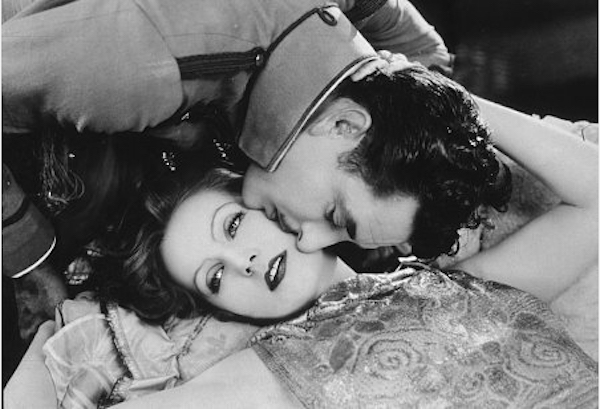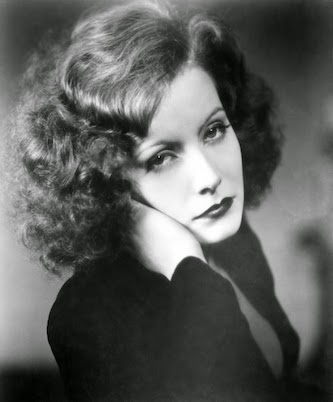Film Reconsideration: Greta Garbo — 30 Years After Her Death
By Gerald Peary
Women’s maltreatment for 3,000 years registers on Greta Garbo’s tragic visage, whether she is Anna Christie, Camille, or Queen Christina.

Greta Garbo and John Gilbert in Flesh and the Devil. Photo: Wiki Common.
“I want to be alone,” said Greta Garbo.
Contrary to popular lore, she never said it in real life in those words. She said it three times in a film, Grand Hotel (1932), as a forlorn, socially distancing ballerina. Still, the line stuck, and ultimately became her credo. For more than half a century of retirement, the world-famous actress stayed out of the spotlight, maintaining her solitude though residing in midtown Manhattan. Garbo sightings, of course, were the stuff of legend. Someone saw her in 1962, she observing the twisting-the-night-away patrons from the shadows of the Peppermint Lounge. On another occasion, a New Yorker ducked into a doorway from a rainstorm. Garbo had found sanctuary there too. The rain subsided, Garbo swiftly walked away.
Her insistence on privacy was no thespian show of temperament. Give Garbo her due. She died 30 years ago at age 84 in 1990 without breaking her vow of public silence. There was no TV setting the record straight with a heart-to-heart with Barbara Walters. As for movies, Garbo made her last in 1941, Two-Faced Woman. Then she shut her career down, before Pearl Harbor and during Franklin Roosevelt’s third presidential term.
What is her legacy?
Above all, there’s The Face. In 110 years of Hollywood, there’s been only one Garbo in close-up. Her favored MGM cinematographer, William Daniels, experimented once, trying to shoot Garbo ugly. He just couldn’t do it. Said screenwriter Philip Dunne: “A Harvard professor of mine took his class — it was a class in Renaissance sculpture — to see Flesh and the Devil so we could look on Garbo as the perfect classical face.”
The royalty cheekbones, the half-moon eyebrows, the long, straight nose, the large, sulky mouth. The Garbo Look is always proud and defiant yet her brow is furrowed, shadowed by trouble. Inevitably, it’s male trouble. Women’s maltreatment for 3,000 years registers on her tragic visage, whether she is Anna Christie, Camille, or Queen Christina.
Garbo’s characters, said New York Times critic Bosley Crowther, “were usually women who had driving, shameless, passionate needs for men, not merely for sexual satisfaction but for the deeper fulfillment of the soul.” Men loved her, then often they loved her not, or abandoned her. Male worldly duty called and, oh, how unworldly Garbo suffered. She fell through the ice in Flesh and the Devil, leapt under a train in Anna Karenina, and coughed and coughed and died in Camille.

Greta Garbo — her melancholic, masochistic portrayals seem a trifle archaic today.
Her melancholic, masochistic portrayals seem a trifle archaic today, and also her mannered acting. Styles change, and the post-Method naturalism of current screen performers has nothing in common with Garbo’s husky-voiced, moony histrionics, her showy, chameleon shifts of mood and emotion, while sometimes muttering the corniest of Hollywood lines. Blame Metro-Goldwyn-Mayer, where Garbo made all her pictures, because tempestuous overacting–John and Lionel Barrymore!– was its 1930s studio style. Let’s admit it: Garbo’s moody, quivering dance queen in MGM’s Grand Hotel totters dangerously toward camp.
But treat her right, and Garbo was great.
In Flesh and the Devil (1927), a silent classic, she was teamed with her off-screen amour, John Gilbert. On screen, they were a formidable pairing. Who needed dialogue with their torrid clinches? This time, Garbo wasn’t fabricating love, and the wild emotions could be felt from Sunset Boulevard to her native Sweden. Directed by George Cukor in Camille (1937), Garbo found a reality in the most improbable of 19th-century melodramas. She was the tubercular mistress of Robert Taylor’s callow Armand and my, how she succumbed, a virtuoso scene in which the Great Beyond registered on her suddenly stone-cold face. Critic Gary Carey called Garbo’s Camille “the single most beautiful performance in the American sound film.”
Finally, there was Ninotchka (1939), with a gift of a comic script by Charles Brackett and Billy Wilder and the most deft, light-of-touch direction from the great Ernst Lubitsch. Surrounded by such talent, Garbo boldly shined, playing a brusque Soviet commissar who, assigned to Paris, discovers the delights of Western-style makeup, clothing, and romance. Dour Garbo in a comedy? Nobody before Lubitsch allowed free reign for her warmth and humor. “Garbo laughs,” announced the Ninotchka ads. She also kicked up her heels, screwball style. After Ninotchka, Garbo was ready for anything. Unfortunately, MGM assigned her the demeaning Two-Faced Woman.
What possibly could be sillier? Garbo played twins. MGM president Louis B. Mayer was said to complain at the distressing first screening: “You can’t tell them apart.”
So Garbo retired, brought down by the failure of her final picture. But did Garbo plan to abandon Hollywood forever? The evidence is that, after a long break, she hoped for a return: there’s a 1949 screen test in the library collection at the University of Wisconsin. But the projects in which she expressed interest were fascinating pipe dreams: for example, Garbo as Oscar Wilde’s androgynous Dorian Gray pursuing young Marilyn Monroe.
So finally, she really gave up. Gone but assuredly never forgotten. Was she the greatest screen actress in the history of cinema? Hardly. The greatest screen presence? Greta Garbo is as splendid a choice as any. As critic Kenneth Tynan famously proclaimed, “What, when drunk, one sees in other women, one sees in Garbo sober.”
Flesh and the Devil is available streaming through Daily Motion. Anna Christie and Ninotchka are on You Tube, Grand Hotel, Anna Karenina, and Queen Christina on Amazon Prime. Camille and Two-Faced Woman are currently unavailable streaming.
Flesh and the Devil Daily Motion: https://www.dailymotion.com/video/x20cdgd
Anna Christie: YouTube https://www.youtube.com/watch?v=t9TDc2VMSx0
Grand Hotel: Amazon Prime https://www.amazon.com/Grand-Hotel-Greta-Garbo/dp/B001NZB5GO
Anna Karenina: Amazon Prime https://www.amazon.com/Anna-Karenina-Greta-Garbo/dp/B001NN0CTC
Queen Christina: Amazon Prime https://www.amazon.com/Queen-Christina-Greta-Garbo/dp/B06XYV85FL
Ninotchka: YouTube https://www.youtube.com/watch?v=YhTcSMrOXc8
Gerald Peary is a Professor Emeritus at Suffolk University, Boston, curator of the Boston University Cinematheque, and the general editor of the “Conversations with Filmmakers” series from the University Press of Mississippi. A critic for the late Boston Phoenix, he is the author of nine books on cinema, writer-director of the documentaries For the Love of Movies: the Story of American Film Criticism and Archie’s Betty, and a featured actor in the 2013 independent narrative Computer Chess. His new feature documentary, The Rabbi Goes West, co-directed by Amy Geller, is playing at film festivals around the world.

Agree that the high points of her acting were as Ninotchka and Camille. In defense of her performance as Grusinskaya, I suggest you watch the documentary “Ballet Russes”(2005). Garbo caught the spirit of cocooned, extravagantly emotional Russian ballerinas perfectly.
I’ve seen it. I agree.